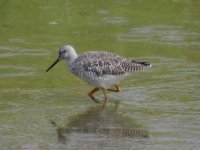The only book I have with info on these shows two very similar pictures, yet cites that the main distinguishing feature other than size is the lenght of the bill. Unfortunately, the photo present of the greater and lesser both have similar length bills (porportionally).
Any clues as to which one this is?:
Any clues as to which one this is?:





